
June 2019
As DSA
Grows, SAlt Splinters, ISO Implodes
Left Reformists
In Existential Crisis
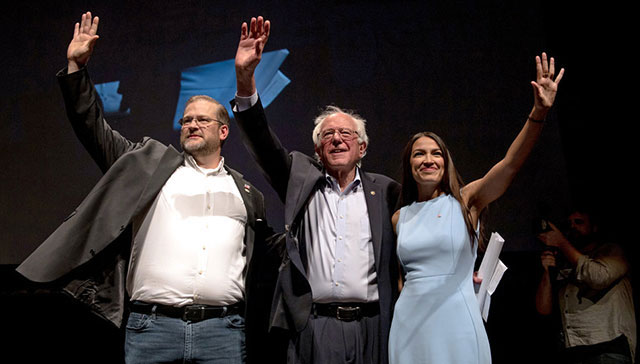
Kansas congressional candidate James Thompson with “democratic socialists” Senator Bernie Sanders and future Congresswoman Alexandria Ocasio-Cortez in Wichita, July 2018. One calls to “abolish I.C.E..” the others don’t, but they all are for “secure borders.” And they all run for office in the Democratic Party of imperialist war, racist repression and mass deportations. (Photo: New York Times)
Buffeted by social and political crises that make the phrase “capitalist decay” palpable on a daily basis, the United States is already neck-deep in the muck of the next presidential campaign. With Republicans firmly congealed around that embodiment of vileness, Donald Trump, by June no less than 24 Democratic hopefuls had entered the field for the 2020 nomination. While most “progressives” would vote for anything, including maybe even an actual donkey, if it won the Democratic nomination to oppose Trump, Bernie Sanders’ presidential campaign has once again drawn the hopes and illusions of the majority of self-identified leftists.
As in 2016, the political and social function of Sanders’ campaign is to renew and refurbish the subjugation of workers, youth and the oppressed to U.S. imperialism’s Democratic Party. Crossing yet another “t,” in early March he signed a “loyalty pledge” demanded by the Democratic National Committee to run as a Democrat and govern as one if elected. And once again, the reformist left jumps to do its part in presenting this bourgeois politician, running for the nomination of the oldest capitalist party in the world, as a “socialist.” What does this mean? As a headline summarizing comments by the senator from Vermont put it: “Bernie Sanders: ‘Democratic Socialist’ Is Just a Synonym for New Deal Liberal” (New York magazine, 23 April).
Indeed, together with fellow star of Democratic (Party) “socialism,” Alexandria Ocasio-Cortez, Sanders takes every opportunity to present his positions as the continuity of Franklin D. Roosevelt. FDR’s New Deal politically and militarily rearmed U.S. imperialism in the midst of the social upheaval of the Great Depression. It brought about the so-called “New Deal coalition” that for generations cemented Democratic hegemony over labor, African Americans and many urban whites plus the left, subordinating their struggles to this main party of U.S. imperialist capitalism.
DSA Growth Posed Existential Challenge
Sanders’ last campaign, together with revulsion at the election of Trump, led to the mushrooming of the Democratic Socialists of America (DSA). This long-stagnant social-democratic pressure group on and in the Democratic Party rocketed from an official 6,500 (actually much less) to a formal membership of over 50,000 members, largely “millennials.” This posed an existential challenge to reformist socialist groups like the International Socialist Organization (ISO) and Socialist Alternative (SAlt) which occupied political space a bit to the left of liberal Democrats.
These organizations, together with the ephemeral “DSA left” and a range of smaller groups, joined in hailing the surge of “Democratic (Party) socialism” as the birth of a “new socialist movement.” Last year, their excitement boiled over with the primary victory and subsequent election to Congress of DSA member Ocasio-Cortez. As we wrote in August 2018:
“The influx of new members, they insisted, was radicalizing the DSA in a process that would push it away from and eventually out of the Democratic Party. The scientific Marxist term for this is: bullshit. As shown by the Ocasio-Cortez campaign ... the DSA and its new members are moving further into the Democratic Party. And this, in turn, helps push the fake-left groups cheering them on further to the right, as they seek ever deeper unity with the mainstream social democrats.”
–“Alexandria Ocasio-Cortez to the Rescue of the Democratic Party,” The Internationalist No. 53, September-October 2018
The rise of Ocasio-Cortez (“AOC”) and the accompanying non-stop media hype “have deepened the dilemmas that Bernie Sanders’ ‘political revolution’ posed for the opportunist left,” our article noted. “Pushed and pulled to be more and more ‘Democratic’ and less and less ‘socialist,’ they’re scrambling to figure out how best to enthuse ... but still justify their own existence.” While claiming to have something in common with Leninism and even Trotskyism, groups like SAlt and the ISO “gush over the DSA’s growth and ‘successes,’ rightly seeing themselves as part of a social-democratic confraternity. But grabbing a piece of the action won’t be so easy.” It was clear that SAlt, like the ISO, “faces more internal turmoil as it inevitably confronts the question: ‘All the way with the DSA?’”
In fact, the ensuing period has been one of growing crisis for reformist groups nominally to the left of the DSA. The one that most unabashedly threw itself into the Sanders campaign, Socialist Alternative, has dwindled and split, losing a huge chunk of its membership and a whole series of locals. More circumspect, the International Socialist Organization hailed the bourgeois politicians Sanders and Ocasio-Cortez as fellow socialists while hovering at the edge of formally endorsing them, leading to extensive public debates. Its political travails fueled an organizational crisis that terminally catalyzed in a #MeToo-type scandal early this year. Its implosion took place in a matter of weeks – amid a torrent of convulsive soul-searching – and on March 29 the ISO, which for many years described itself as the largest group on the U.S. left, declared its own dissolution.
In common with a number of other reformist outfits, including the Workers World Party (which has been decimated in a three-way split) in the U.S., the ISO and SAlt have been devoured by their own opportunism.
SAlt, CWI In Crisis
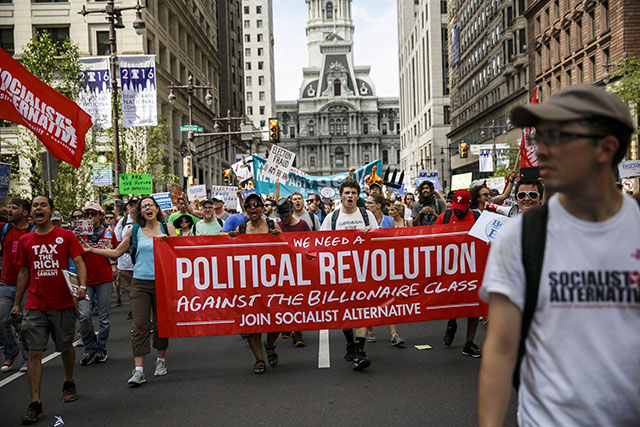
Socialist Alternative marches during Democratic Party convention in Philadelphia, July 2016, echoing the slogans of would-be Democratic presidential nominee Bernie Sanders. (Photo: Marcus Yam / Los Angeles Times)
Socialist Alternative, affiliated with the Committee for a Workers International (CWI) long led by British pseudo-Trotskyist Peter Taaffe, has since its inception in the 1980s centered its activity on one low-level reformist campaign after another. It made a splash in November 2013 when SAlt member Kshama Sawant was elected to the Seattle City Council on a program of liberal/populist reforms. Sawant spearheaded a single-issue campaign that led to the city passing a law in 2014 that would, over several years, phase in a minimum wage of $15 an hour. The group expanded rapidly, boasting of building new branches in “dozens of cities.” Sawant’s deepening alliances with local Democrats paved the way for her voting last year to support the new chief of police.[1]1
In the spring of 2015, when Bernie Sanders announced his candidacy for the 2016 Democratic presidential nomination, SAlt’s leadership thought positioning themselves early and enthusiastically as Bernie’s “socialist” best builders would be their ticket to the big time.2 Jumping in with both feet, the group quickly sank up to its eyebrows in outright bourgeois politics, coming up with one supposedly clever “tactical” pretext after another to justify it all.
Launching what came to be known as SAlt’s “Bern turn,” they formed a “#Movement4Bernie,” parroting Sanders’ populist slogan about a “political revolution against the billionaire class.” The fact that it was all about recycling New Deal rhetoric to renew and refurbish the Democratic Party (as Sanders explicitly proclaimed), was on display when SAlt’s Sawant gave Sanders “a socialist welcome” to Seattle at a Democratic campaign event in August 2015 commemorating Roosevelt’s establishment of Social Security and Lyndon Johnson’s establishment of Medicare.
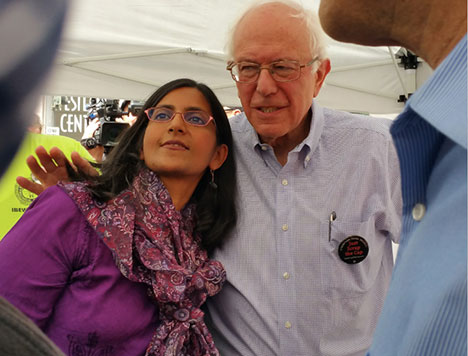 Seattle city council member
Kshama Sawant of Socialist Alternative with Bernie Sanders, at
2015 Sanders rally.
Seattle city council member
Kshama Sawant of Socialist Alternative with Bernie Sanders, at
2015 Sanders rally. (Photo: KUOW)
The fig leaf SAlt used to justify its support to Sanders’ capitalist campaign was its claim that it would push him to run as an independent if he did not win the Democratic nomination. But as he said all along he would do, Sanders gave his support to Hillary Clinton in the general election. Building Sanders’ campaign with ever-expanding pretexts and rationalizations, SAlt succeeded in helping him rope new and younger forces into the Democratic Party.
What SAlt’s political acrobatics did not succeed in doing was pole-vaulting them into the big time as the group’s leadership had imagined. With the Democratic Socialists of America growing by leaps and bounds, cheered on by much of the bourgeois media, SAlt’s frantic boosterism looked downright pathetic. If this is what “socialism” meant, why not join with those who were bigger and better at the game? Soon enough, whole branches of the organization decamped further to the right, toward the DSA or the Greens.
As SAlt threw itself into campaigning for Alexandria Ocasio-Cortez and other DSA Democrats last fall, a section of its leadership and membership, headed by former Sawant campaign political director Philip Locker and Ramy Khalil, took the next logical step and took off for the DSA. (They now call themselves the “Reform & Revolution Caucus”!) In contrast, a number of left dissidents were drawing opposite conclusions, as their fight to uphold the political independence of the working class led them to fuse with the Internationalist Group and Revolutionary Internationalist Youth.3
Meanwhile, Taaffe’s CWI is in a deep crisis. With Taaffe and other leaders of the International Secretariat accusing the Irish section of capitulation to identity politics and petty-bourgeois feminism, only a minority of the International Executive Committee has supported the faction formed by Taaffe. Opposition groupings emerged, including one called the “Non Faction Faction” (!), and the Spanish and Portuguese sections have now reportedly walked out. Further turmoil and divisions are clearly on the agenda. For the CWI as for its U.S. supporters, the fruits of opportunism are proving increasingly bitter.
Yet as the crisis of reformist left organizations has escalated, some former members have responded by joining cobbling together undifferentiated “broad socialist” groupings (Philly Socialists, Marxist Center, etc.) dedicated to maintaining “unity” by evading clear lines of demarcation on contentious issues. Former ISO branches have reappeared as Chicago Socialists, Madison Socialists, Central Ohio Revolutionary Socialists, etc. For some activists this involves what they call “base-building” – low-level social work based on the paternalistic idea that the oppressed will only be drawn to socialist groups that “do something concrete for them” (like fixing brake lights) right now. Others have sought to revive the anti-Leninist doctrines of Karl Kautsky, the “pope” of the social-democratic Second International that blew to pieces when its parties supported their “own” bourgeoisies in the first imperialist world war.
But in any case, such amorphous groupings, whatever their particular “points of agreement,” are based on rejection of the revolutionary communism of Lenin and Trotsky’s Bolsheviks, and thus cannot lead the class struggle forward.
Behind the ISO’s Collapse
Amidst the crisis of much of the left, the most spectacular occurrence of the recent period has been the collapse of the International Socialist Organization, culminating in its dissolution in late March. This was an anguishing experience for hundreds of its former members. Although the final act of the ISO’s demise was marked in particular by its embrace of #MeToo, its collapse is fundamentally due to its overall opportunist politics and the predicament it found itself in as the burgeoning DSA occupied its hoped-for political space. The post mortems by various left groups skirt or downplay the political issues and underlying causes of the ISO’s political self-immolation. This is natural enough for analyses coming from other sectors of the left that largely share the ex-ISO’s tailist approach and social-democratic program. Many clearly hope to cash in on its collapse without challenging its former members’ basic outlook (which does no favors to any among them seeking a revolutionary way forward).
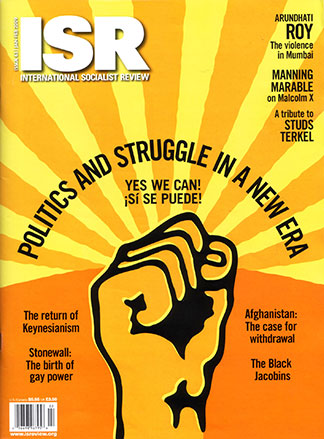 Opportunism was always the
name of the game. ISO theoretical journal hailed Obama’s 2008
election, cynically echoed campaign slogan, proclaimed Wall
Street Democrat brought “new era.” Members were taught this
meant “meeting people where they’re at.”
Opportunism was always the
name of the game. ISO theoretical journal hailed Obama’s 2008
election, cynically echoed campaign slogan, proclaimed Wall
Street Democrat brought “new era.” Members were taught this
meant “meeting people where they’re at.” The ISO claimed to be a Marxist organization and on occasion, when convenient, even to have something to do with Trotskyism. During and after its implosion, a range of commentators and some former members attributed its demise to “Leninism” and/or Lenin’s organizational principle of “democratic centralism.” But mistaking the label for the contents is never a good idea, least of all in politics. The actual politics of the ISO were far indeed from revolutionary Marxism and Leninism, and entirely counterposed to the program and outlook of Trotsky and the Fourth International he founded as the world party of socialist revolution.
Instead, the approach and method of the ISO was to position itself a step to the left of mainstream liberalism and try to nudge the liberals, and the “movements” of the day they dominated, in that direction. Its members were trained in the idea that this meant “reaching people where they’re at” since going through the experience of the movement du jour would wind up radicalizing them. As for Trotsky’s call to “speak the truth to the masses, no matter how bitter,” this, for the ISO, was a hallmark of much-reviled “sectarians.”
Paternalist justifications for adapting to existing consciousness are the stock in trade for left groups that, like the ISO, have spread illusions in everything from SYRIZA in Greece to the “Arab Spring” – but in the United States, it means above all tailing and reinforcing illusions in the Democratic Party. The ISO’s formula for recruiting liberal youth was that socialists are the most “consistent” liberals on every issue, whereas liberal Democrats are “unreliable” and inconsistent. The fundamental Marxist conception of the class line was profoundly alien to this view of politics as a continuum in which socialism is the most consistently “progressive” variant of bourgeois liberalism.
Maintaining illusions in the Democratic Party, and the subordination of the workers and oppressed to it, is the daily bread of the leaders of the labor movement as well as almost all other social movements in this country. The Democratic Party is the keystone of liberal imperialist politics, and over the recent period the ISO echoed its propaganda themes from the “Syrian revolution” to “Russiagate.” This was prepared by the entire political tradition of the ISO rooted in Cold War “Third Camp socialism” (see accompanying article).
As the Niche Dwindled
All of this meant that the rapid growth of the DSA and the identification of Bernie Sanders, AOC & Co. with “socialism” deprived the ISO of the political niche it had long occupied. Entirely imbued with tailism, the ISO itself could not help but contribute to this process. Always hoping to get in on the action, its praise of the Democratic “socialists” instead helped cut away the basis for its own existence.

Issue after issue of the ISO’s Socialist Worker hailed Sanders, AOC et al. as putting “socialism in the air,” chimed in with the willfully deceptive claim that these imperialist Democrats are socialists (while giving some tips on how to do it better), and breathlessly applauded their electoral advances – while pretending for the record not to actually “endorse” them.
The pretense was less than paper-thin, and could not hold. It didn’t. Our August 2018 article on Ocasio-Cortez and Democratic “socialism” described in detail the roiling public controversy among ISO leaders over how to relate to this “movement” of and into the Democratic Party. The ISO might well be facing a “hemorrhage of members, perhaps a split,” we wrote. “Whatever, things certainly aren’t looking good for the ISO.” We can scarcely be accused of overstating matters.
A telling glimpse of what things looked like on the ground as the denouement approached is provided by events at the City University of New York’s Brooklyn College in early March. This was the location that Bernie Sanders chose to launch his new campaign, for the 2020 Democratic presidential nomination. “Remembering his roots and connection to the borough, Sanders chose his alma mater as the first stop” on his campaign trail, the college’s website proclaimed on March 2, after “huge crowds turned out” for the rally that day.
The ISO’s student group on campus was “Brooklyn College Socialists,” devoted to promoting the organization’s standard-issue liberal/reformist themes. Its recruitment event at the beginning of the Spring 2019 semester was “Are You a Socialist Too?” and featured a picture of Alexandria Ocasio-Cortez. What, then, would be their response when Bernie Sanders’ March 2 rally, on their very own campus, was announced? It could only have seemed natural when they hosted a “Banner Making for Bernie” event the day before the rally, then bedecked their Facebook page with photos of themselves “mingling” at the campaign launch accompanied by the hashtag “#bcfeelingthebern.”
The Final Conference
The beginning of the end was the ISO national convention in February that ousted virtually the entire long-time leadership centered on Ahmed Shawki and Sharon Smith along with other veterans like Paul D’Amato and Lance Selfa. A subterranean revolt had been brewing for some time, as accumulated grievances against this ingrown, domineering circle grew increasingly bitter. A “Steering Committee Majority” faction was put together to oust the old guard, which found itself reduced to a small minority. We have little reason to doubt the overall charge of bureaucratism directed against them: the fact that the organization had been run by a clique was perfectly obvious even from the outside.
Reformist parties are necessarily bureaucratic, subordinating the membership to what is acceptable to bourgeois “allies” while suppressing any stirrings of a radical challenge. As the ISO veered from one opportunist campaign to another, pumping up ever-new predictions of success (and churning through members at a rapid rate), the leadership doubtless feared that some might take the opportunism “too far,” at the same as it could not tolerate even the possibility of any real political balance-sheet.
Genuinely revolutionary organizations must be self-financing; a working-class party depends on the hard-earned material support of its members. One of the characteristics of opportunist organizations around the world is their dependence on government subsidies, parliamentary paychecks and/or private-sector bourgeois largesse. While no one in the ISO apparatus was making a mint, its leadership was intertwined with and to a large degree financially dependent on the Center for Economic Research and Social Change, largely funded by liberal bourgeois foundations. This material and political reality could only mean that talk of accountability to the ranks would be pie in the sky.
Sundry social democrats posthumously dissecting the ISO’s debacle try to pin the blame on “Leninism.” As they know and is patently obvious, what the ISO actually did and stood for in real life bore no resemblance to Bolshevism. As for “democratic centralism” as put forward by Lenin, this is the organizational form for advancing a revolutionary program. Counterposed to the bureaucratic machinations of social-democratic and Stalinist parties, it corresponds to the needs of a proletarian vanguard party that can lead the workers, at the head of all the oppressed, to power.
To serve the goal of overthrowing capitalism, such a party requires genuine internal democracy and debate to defend, develop and sharpen the revolutionary program, and correct its course when needed; it requires centralism, unity and discipline in action to bring that program into the class struggle and lead the combat against the class enemies of the proletariat and the oppressed. The ISO’s continual tailing of bourgeois liberalism and existing (bourgeois) consciousness could only stand in the way of a real struggle against oppression. Its reformist politics and evasion of sharp political demarcation (as well as genuine internal struggle) were antithetical to the task faced by genuine Marxists: forging revolutionary cadres able to fight the oppression and reactionary backwardness bred by capitalist society, and to win the working class to this fight.
For Leninist revolutionaries, the struggle for black liberation and the emancipation of women, and against all forms of social oppression, is the task and responsibility of the entire party and all its members. As part of this task, a genuinely revolutionary party must give sustained, special attention to developing women, African American and Latino leading cadres, all the more so as in this country born of slavery, the “black question” is key to virtually every aspect of politics and strategic to socialist revolution. In contrast, for reformist parties faced with demands to take issues of special oppression seriously, the response is tokenistic sectoralism, parceling the task out to caucuses “representing” each oppressed group. As the ISO sank into the swamp of bourgeois liberal “identity politics,”4 it also faced growing accusations of stifling the development of members from specially oppressed groups. The response was to proclaim a “people of color caucus,” a “trans caucus,” etc.
Most directly connected to the impending dissolution of the ISO, and the extraordinary rapidity with which this was carried through, was the formation of a “#MeToo commission” as well as a “survivors’ caucus.” Together with hailing the women’s marches centered on “getting out the vote,” the ISO had fully embraced the #MeToo movement” that has harnessed outrage against real crimes against women in this violently oppressive society to the political objectives of Democratic Party feminism. This involved adopting the feminist dictum that one must a priori “believe all women” – or risk being branded an apologist for the horrendous crimes of rape and sexual assault. All the more so in this racist and homophobic society, this is a recipe for witch hunts.5
Denouement
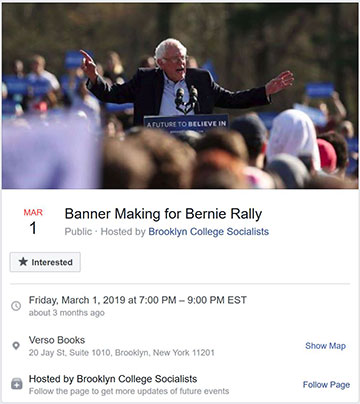 How things looked on the
ground on eve of ISO dissolution. “Brooklyn College
Socialists” make banners for Bernie rally launching his bid
for Democratic 2020 presidential bid.
How things looked on the
ground on eve of ISO dissolution. “Brooklyn College
Socialists” make banners for Bernie rally launching his bid
for Democratic 2020 presidential bid. (Facebook)
When the new Steering Committee received and circulated a March 11 letter by a former member on the organization’s handling of a 2013 rape allegation, the ensuing uproar ripped to shreds the official optimism proclaimed by the February convention. The person accused of rape, who had been elected to the new Steering Committee, was expelled, and all the individuals who had been part of the Steering Committee in 2013 were suspended from leadership positions on the basis that they had allegedly protected him by pushing to reverse a disciplinary committee finding of guilt, on grounds that he was denied the opportunity to make his case to the investigating body or to rebut witness testimony.
On March 15, the new Steering Committee published on the Socialist Worker website a “Letter to the ISO Membership” that, among other things, pledged to “study how the ISO can relate to socialist campaigns [sic] run on Democratic ballot lines.” Central to the statement was denunciation of the organization’s “damaging political culture,” depicted as a longstanding pattern of abuse. As activists who had devoted years to the organization struggled to understand the events, widespread resignations ensued in an atmosphere of mass panic. Though a few still sought to keep some semblance of the old edifice together, a March 24-29 online poll of the remaining members and recently resigned ex-members resolved to dissolve the ISO and cease publication of Socialist Worker.
On April 19 the ex-Steering Committee issued a last declaration. Reporting that the “final steps” in the ISO’s dissolution had been completed, it stated that “the highly unusual step of voting to dissolve the organization” had been “guided by the recognition that the ISO’s demise was inevitable.” The statement ended with one last pitch for the populist slogan of “socialism from below,” the calling card of groups embracing the ISO’s spiritual godfathers, Tony Cliff and Max Shachtman (see accompanying article).
Like the rise of “Sanders socialism,” the fall of the ISO is
part of a broader crisis of the reformist left. Just as the
growth of the Democratic (Party) Socialists of America is no
“new socialist movement,” the debacle of groups on the left
flank of social democracy is no “crisis of Leninism.” Quite
the contrary, it is a dramatic reaffirmation of the
indispensability of genuine Leninism for building a
revolutionary leadership. Against capitalist barbarism,
communism lives in the worldwide struggle of the workers and
oppressed, and the Trotskyist program for carrying it through
to victory. Those who want to contribute to making this happen
should study and learn from these events. ■
The above article is part of the Internationalist Group
pamphlet, Left Reformists in Existential Crisis
(June 2019). To download a pdf copy of the pamphlet click here.
To order a print copy of the pamphlet, click here.
- 1. See “SAlt's Sawant Backs Seattle's Top Cop,” The Internationalist No. 53, September-October 2018.
- 2. See “Bernie Sanders and the Pressure Politics of the Opportunist Left” (June 2015), reprinted in the Internationalist Group pamphlet DSA: Fronting for the Democrats, February 2018.
- 3. See “An Open Letter to Socialist Alternative Oppositionists, Past and Present” and “Class Struggle Education League Fuses with Internationalist Group,” The Internationalist No. 52, May-June 2018; “Socialist Alternative Is No Place for Revolutionaries,” The Internationalist No. 54, November-December 2018; and “Spokane Marxist Group and Marxist Student Group Fuse with Revolutionary Internationalist Youth,” Revolution No. 16, May 2019. These materials are reproduced in the Appendix of this pamphlet.)
- 4. As we have written, “This form of bourgeois ideology feigns a fight against oppression through ‘check-your-privilege’ liberal idealism.... It is used to deepen the wedge between different sectors of the workers and oppressed, claiming to unite those who share a sectorally defined identity, including members of the exploiting class.... Ostensibly radical versions ... give left cover to this bourgeois ideology rather than forthrightly explaining how it can never be a program for actually winning liberation” (“Founding Declaration of the Revolutionary Internationalist Youth,” August 2017) reprinted in Revolution No. 14, January 2018. The ISO’s embrace of identity politics meant renouncing even its own prior critique, such as the well-researched article by Sharon Smith, “Mistaken identity – or can identity politics liberate the oppressed?” International Socialism, Spring 1994.
- 5. For an in-depth discussion of these vital issues, see “Democratic Party Feminism and the ‘#MeToo Movement',”The Internationalist No. 55, Winter 2019.
